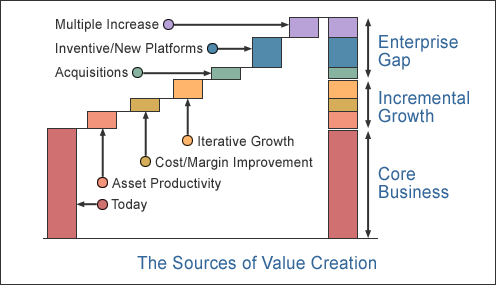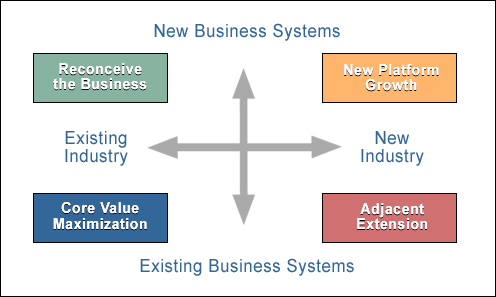 |
 |

 |
 |

Product line extensions, geographical
expansion and new technologies and
adjacencies aren't enough.


Performance shortfalls create a "results
gap." But limitations of growth are caused
by organizational and process gaps.


Building the team and its methods.


The characteristics and processes of an
"Entrepreneur in Residence."


Going beyond the creative into a
practical and executable model for
sustained growth.

|
 |
 |
 |


Oyster-centric definitions of terms used
on this site.

|
 |
 |
 |
|
 |
 |
The qualitative difference in truly new platforms is real. These new markets offer under-exploited opportunities where platforms can grow in two dimensions: up and out.

|
 |
 |
|
 |

The Growth Challenge
As a market matures, the work of leadership is to identify the next emerging market opportunity. For mature organizations the effort is essential because the growth of their core businesses inevitably slows, flattens and then begins to decline. This is the natural result of consistent offerings in a competitive and changing world. In effect, it is the natural tendency of businesses to shrink as they mature. To prevent this, new opportunities must be found.

Growth Plans
Plans for business growth begin with an examination of existing business units and the opportunities they present. So, in the normal course of events, business units are required to forecast growth during upcoming periods based on the perspectives their managers bring to bear on the challenge. At their heart, these managers' method is to create efficiency around known tasks, adding value to existing structures, maintaining brands and expanding within the scope of established products and services. They are excellent at managing the known and so look to it for growth.



Asset productivity, cost/margin improvement and iterative growth (line extensions, geographical expansion and adjacencies) are all "incremental" additions to the core business. Inevitably, the growth goal for the enterprise as a whole exceeds the sum of these contributors. Acquisitions, new platforms and the multiple increases they can generate, have to make up the difference.

The resulting forecasts predict the benefits to be derived from product line extensions, geographical expansion and new technologies and adjacencies. But these strategies rarely outperform GDP growth because they reflect a process that is applied to an already maturing environment and so result in benefits that are understandably limited.

There are many effects of the disappointing growth from this source. Not the least of which is a financial market valuation that is steady state, rather than a growth valuation. As important, the vitality and long-term health of the organization is compromised by unexceptional performance of this kind.

New Domains
Adding additional growth to the incremental progress of existing business units requires expansion of the business' terrain into new domains. Within those new domains, appropriate new platforms can be found, developed and grown at rates greatly exceeding existing business units.

New Platforms
Truly new, non-adjacent platforms offer two significant benefits. The first is to provide new growth real estate, new business space in which to expand. In this space products can grow and spawn other new platforms. There is an intrinsically more promising potential in these under-explored territories. Better still, successful new platform development creates a culture of growth where the different methods and personalities required are rewarded and their contributions made clear to the entire organization.



The underlying, exploratory nature of new platform growth.

The qualitative difference in truly new platforms is real. These new markets offer under-exploited opportunities where platforms can grow in two dimensions: up and out. "Up" in the sense that the new platforms revenues and profits will grow. But as important, "out" in the sense that the new, non-adjacent platform provides new growth territory that will spawn further (albeit adjacent) development in areas entirely unexplored in the past. Thus, the new environments are inherently more fertile than the incremental growth of more traditional methods.

Once the organizational structure and processes for new platform development are in place, they self-perpetuate. And the organization develops its own allies because the products and services that are created serve the business unit managers who might otherwise feel threatened and excluded from the process.

For a detailed look at new domains and new growth platforms, click here.

|
 |
|
 |
 |
 |